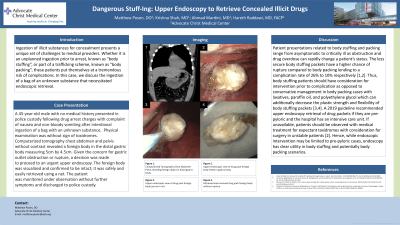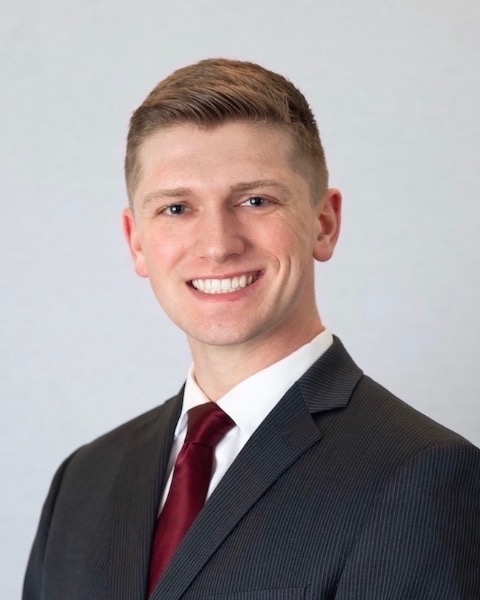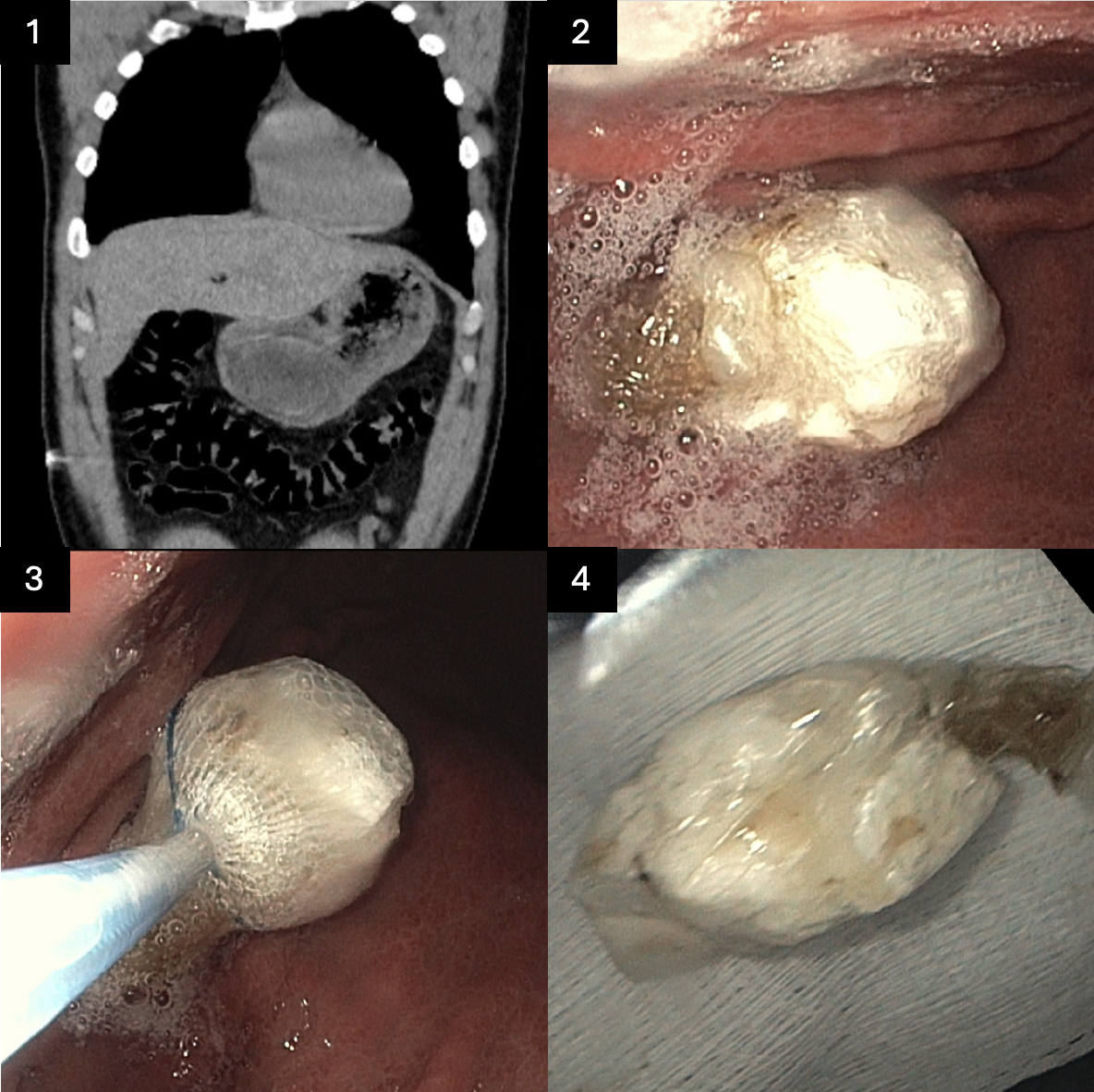Tuesday Poster Session
Category: General Endoscopy
P4137 - Dangerous Stuff-ing: Upper Endoscopy to Retrieve Concealed Illicit Drugs
Tuesday, October 29, 2024
10:30 AM - 4:00 PM ET
Location: Exhibit Hall E

Has Audio

Matthew Posen, DO
Advocate Christ Medical Center
Oak Lawn, IL
Presenting Author(s)
Matthew Posen, DO, Krishna Shah, MD, Ahmad Mardini, MD, Harreth Raddawi, MD
Advocate Christ Medical Center, Oak Lawn, IL
Introduction: Ingestion of illicit substances for concealment presents a unique set of challenges to medical providers. Whether it is an unplanned ingestion prior to arrest, known as “body stuffing”, or part of a trafficking scheme, known as “body packing”, these patients put themselves at a tremendous risk of complications. In this case, we discuss the ingestion of a bag of an unknown substance that necessitated endoscopic retrieval.
Case Description/Methods: A 45-year-old male with no medical history presented in police custody following drug arrest charges with complaint of nausea and non-bloody vomiting after intentional ingestion of a bag with an unknown substance. Physical examination was without sign of toxidromes. Computerized tomography chest abdomen and pelvis without contrast revealed a foreign body in the distal gastric body measuring 5cm by 4.5cm. Given the concern for gastric outlet obstruction or rupture, a decision was made to proceed to an urgent upper endoscopy. The foreign body was visualized and confirmed to be intact; it was safely and easily retrieved using a net. The patient was monitored under observation without further symptoms and discharged to police custody.
Discussion: Patient presentations related to body stuffing and packing range from asymptomatic to critically ill as obstruction and drug overdose can rapidly change a patient’s status. The less secure body stuffing packets have a higher chance of rupture compared to body packing lending to a complication rate of 26% to 10% respectively. Thus, body stuffing patients should have consideration for intervention prior to complication as opposed to conservative management in body packing cases with laxatives, paraffin oil, and polyethylene glycol which can additionally decrease the plastic strength and flexibility of body stuffing packets. A 2019 guideline recommended upper endoscopy retrieval of drug packets if they are pre-pyloric and the hospital has an intensive care unit. If unavailable, patients should be observed with medical treatment for expectant toxidromes with consideration for surgery in unstable patients. Hence, while endoscopic intervention may be limited to pre-pyloric cases, endoscopy has clear utility in body stuffing and potentially body packing scenarios.

Disclosures:
Matthew Posen, DO, Krishna Shah, MD, Ahmad Mardini, MD, Harreth Raddawi, MD. P4137 - Dangerous Stuff-ing: Upper Endoscopy to Retrieve Concealed Illicit Drugs, ACG 2024 Annual Scientific Meeting Abstracts. Philadelphia, PA: American College of Gastroenterology.
Advocate Christ Medical Center, Oak Lawn, IL
Introduction: Ingestion of illicit substances for concealment presents a unique set of challenges to medical providers. Whether it is an unplanned ingestion prior to arrest, known as “body stuffing”, or part of a trafficking scheme, known as “body packing”, these patients put themselves at a tremendous risk of complications. In this case, we discuss the ingestion of a bag of an unknown substance that necessitated endoscopic retrieval.
Case Description/Methods: A 45-year-old male with no medical history presented in police custody following drug arrest charges with complaint of nausea and non-bloody vomiting after intentional ingestion of a bag with an unknown substance. Physical examination was without sign of toxidromes. Computerized tomography chest abdomen and pelvis without contrast revealed a foreign body in the distal gastric body measuring 5cm by 4.5cm. Given the concern for gastric outlet obstruction or rupture, a decision was made to proceed to an urgent upper endoscopy. The foreign body was visualized and confirmed to be intact; it was safely and easily retrieved using a net. The patient was monitored under observation without further symptoms and discharged to police custody.
Discussion: Patient presentations related to body stuffing and packing range from asymptomatic to critically ill as obstruction and drug overdose can rapidly change a patient’s status. The less secure body stuffing packets have a higher chance of rupture compared to body packing lending to a complication rate of 26% to 10% respectively. Thus, body stuffing patients should have consideration for intervention prior to complication as opposed to conservative management in body packing cases with laxatives, paraffin oil, and polyethylene glycol which can additionally decrease the plastic strength and flexibility of body stuffing packets. A 2019 guideline recommended upper endoscopy retrieval of drug packets if they are pre-pyloric and the hospital has an intensive care unit. If unavailable, patients should be observed with medical treatment for expectant toxidromes with consideration for surgery in unstable patients. Hence, while endoscopic intervention may be limited to pre-pyloric cases, endoscopy has clear utility in body stuffing and potentially body packing scenarios.

Figure: Figure 1: Computerized Tomography Chest Abdomen Pelvis revealing foreign object in distal gastric body.
Figure 2: Upper endoscopic view of drug pack foreign body freely in gastric body.
Figure 3: Upper endoscopic view of drug pack foreign body secure in net.
Figure 4: Retrieved and removed drug pack foreign body without rupture.
Figure 2: Upper endoscopic view of drug pack foreign body freely in gastric body.
Figure 3: Upper endoscopic view of drug pack foreign body secure in net.
Figure 4: Retrieved and removed drug pack foreign body without rupture.
Disclosures:
Matthew Posen indicated no relevant financial relationships.
Krishna Shah indicated no relevant financial relationships.
Ahmad Mardini indicated no relevant financial relationships.
Harreth Raddawi indicated no relevant financial relationships.
Matthew Posen, DO, Krishna Shah, MD, Ahmad Mardini, MD, Harreth Raddawi, MD. P4137 - Dangerous Stuff-ing: Upper Endoscopy to Retrieve Concealed Illicit Drugs, ACG 2024 Annual Scientific Meeting Abstracts. Philadelphia, PA: American College of Gastroenterology.
